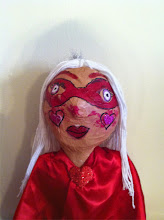Upon first arrival to the dark, ‘Breuerist’ building in the Upper East Side, I was bright eyed and bushy tailed to see The 2010 Whitney Biennial exhibition. It was an oddly sunny, warmish day in early March and I knew that it would not be too crowded and overwhelming, so viewing the art could be an enjoyable experience. Those same emotions changed when I left The Whitney Museum of American Art.
The Whitney Biennial gives the viewer much more space and time to stand in front of each artwork, pause, take it in, and analyze it to your own perspective and opinions. The quantity of variety was exceptional and the works all shared the overall, vague theme of American individuality and unification, a contradiction in and of its self.
2010 is a year of many things, a recession, the first year of our multi-cultural president Barack Obama, a mourning period for the king of Pop, and the 75th edition of this dark building’s exhibition of contemporary American Art. Curator Francesco Bonami and co-curator Gary Carrion-Murayari picked aspects of contemporary American art, put it into a blender and pressed frappe (On High course). There was no one singular theme, material, or voice that ran through this multi-floored Biennial other than the duality of optimism and pessimism in America and the turbulent times in which we live. Successfully, the dialogue of the artwork created does speak to the viewers on a general and personal level and represents events and attitudes of the everyman. This show is much more humble than shows of our past because of the state of our economy and society.
In a review by Jerry Saltz on the 2010 Whitney Biennial, he carries an optimistic view of the exhibition. In his article “Change We Can Believe In,” in the Art Review of New York Magazine, Saltz states, “guest curator Francesco Bonami and co-curator Gary Carrion-Murayari say their show is about innovative forms, new relationships, and personal modernism. Yes, it’s the Obama Biennial: alternately moving and frustrating, challenging and disappointing—and a big improvement on what came before.” Why is it so focused on President Barack Obama rather than the whole of America, rather than one man (granted one powerful, famous man, but one man)? Saltz also states that this Biennial is the first exhibition that the majority of artists is female, however did not create feminist art.
I do agree with Saltz in the fact that the 2010 Whitney Biennial is anti-hype and anti-blockbuster, with no over the top displays of New York gallery-power, wealth, bravado, and high production. The artists represented are not artists of notoriety, on a budget reflecting the rest of America’s lower and middle class. The technical and quality aspects of the artwork vary from artist to artist.
Photographer Nina Berman takes the viewer into a recently returning, disfigured veteran from Iraq, Major Ty Ziegel in “Marine Wedding” (2008.) This photo essay captures Ty and his fiancée on their journey towards the marriage, the disconnection itself of their relationship, and their inevitable separation. I enjoyed Berman’s work because it focuses on issues that our returning veterans are dealing with and their disconnection from the country and the people they love and fight for. Whether you support the wars in Iraq or Afghanistan or not, the viewer is reminded to support of troops.
On a lighter note, artist Pae White, and her work ‘Smoke Knows’ (2009) she creates a cotton and polyester tapestry that “Fuses image and material to stage what she envisions as ‘dream of becoming something other than itself”(Whitney Biennale Catalogue, pg 122.) In this work, she isolates a close up smoke swirl moving gracefully through air and space.
I did enjoy the aspect of the show, art for the every man. But if your paying $18 to see art for the everyman is it any more important in a fancy museum, New York gallery, internet website, or newspaper. If the Whitney Biennial theme is the infinite creativity of America and the growing artistic qualifications, then it is also the theme of art in the 21st century.
The artist that seemed to exemplify the theme of American duality was James Casebere, ‘Landscape with Houses (Dutchess County, NY)’. His blend of set design, photography, architecture, and film is entirely a remake of American surrealism and subject matters expressing American issues. In this particular piece he creates a tabletop scene of an American suburb of upstate New York. This neighborhood was entirely designed as a development and then hard hit with recent foreclosures due to our countries economic state. This work invokes the illusion of the American dream vs. the American reality.
As I left the Whitney Museum of American Art, my mood was dulled to a somber emotion. As an artist I feel like it did an excellent job of reflecting our current time and place but is the illusion of optimism better than facing the realism of our society’s faults. The artist’s general success can hopefully excel and continue for years to come.




No comments:
Post a Comment